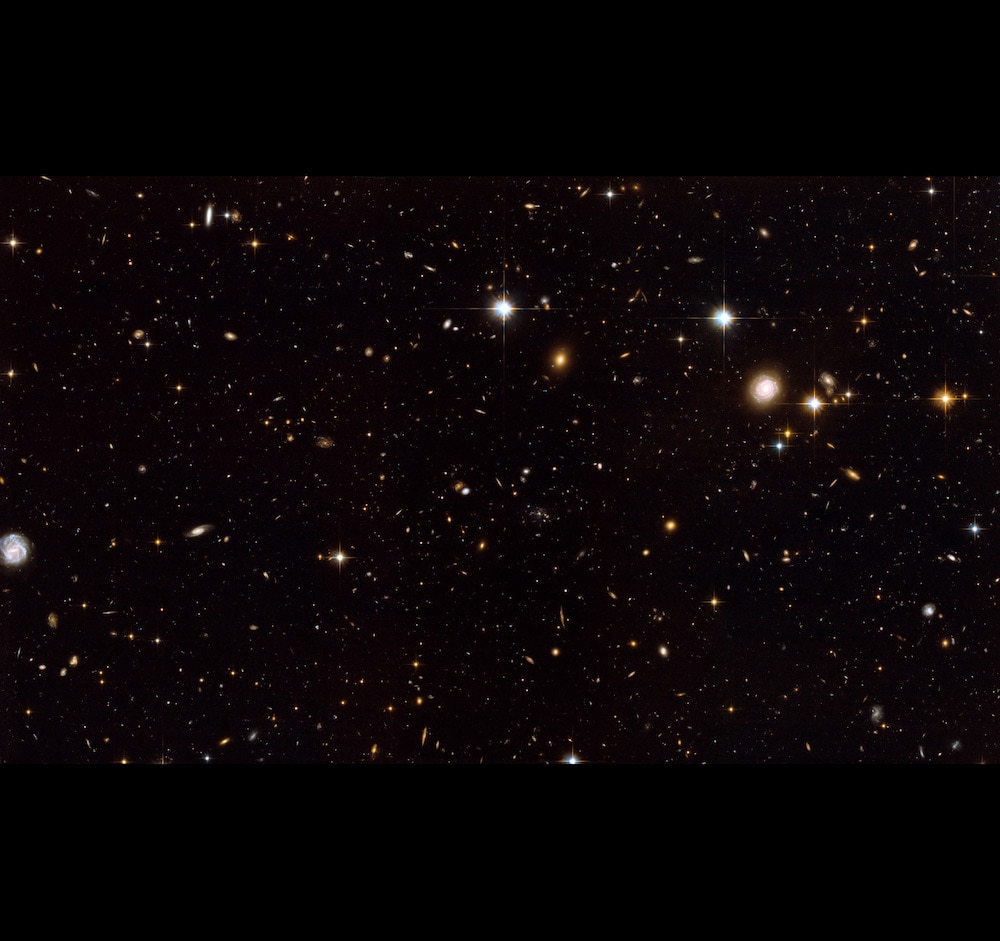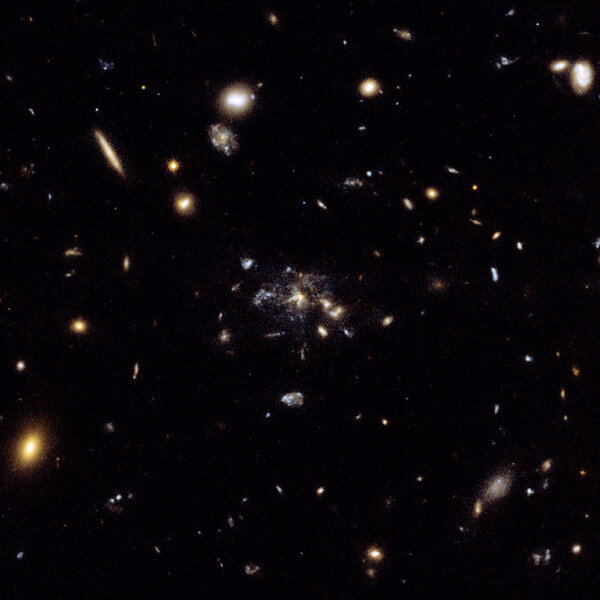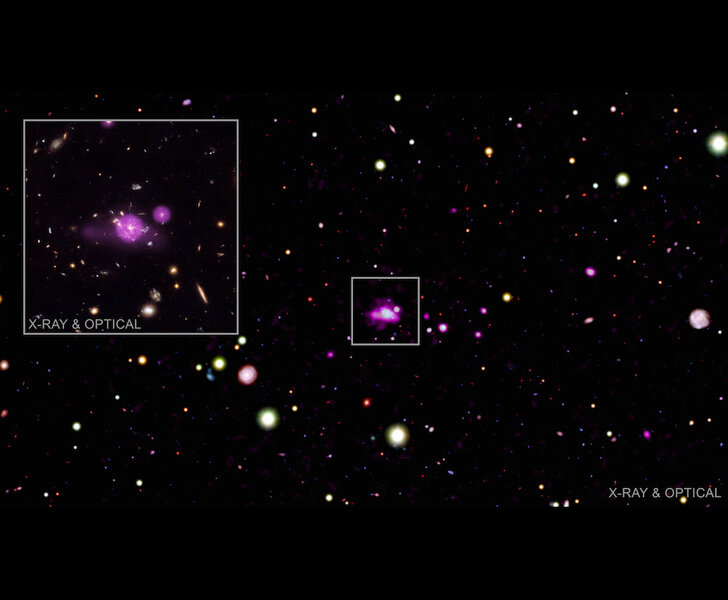Create a free profile to get unlimited access to exclusive videos, sweepstakes, and more!
Over a dozen voracious supermassive black holes seen in a distant galaxy protocluster
Supermassive black holes get an early start in galaxy clusters.

How do galaxies in clusters behave differently then ones that are loners?
In some ways this is pretty well understood. Some galaxies, like our Milky Way, exist in small groups, some are relatively isolated in space, and some are in enormous clusters: vast, sprawling collections of hundreds of galaxies that all orbit their mutual center of gravity.
Clusters tend to have lots of gas between the galaxies, and that falls to the center, accumulating there. The most massive galaxy in the cluster tends to fall to the center, too, so the rich get richer: An already big galaxy can grow as all that gas slides into it. We also see some galaxies traveling through that material losing their own gas; material needed to make stars, so these galaxies wind up dying as they can no longer make stars.
Some galaxies are active: The supermassive black hole in the galactic center is actively feeding on gas, which heats up hugely and can glow so fiercely it can outshine all the stars in the galaxy combined! We see active galaxies in clusters, and, for example, they tend to be more numerous the farther they are from the center.
What about early on in a cluster history? How does galactic behavior change in a cluster over time?
Enter J1140-2629, an active galaxy discovered in 1994. It’s so far from us we see it as it was more than 10 billion years ago, the length of time it’s taken its light to reach Earth. It’s a beast, with over a trillion times the Sun’s mass worth of stars in it — half again more than the Milky Way, which is considered a big galaxy — and it’s blasting out radiation. It has a central supermassive black hole that’s a staggering 20 billion times the Sun’s mass — 5,000 times that of the Milky Way’s black hole Sgr A* — and the light it’s pouring out is mind-numbing; a tightly focused beam of matter and energy shooting out from it is emitting a trillion times the amount of light the Sun is. A trillion.
The galaxy is surrounded by glowing gas that makes it look like a spider in the center of a web, so of course J1140-2629 is nicknamed the Spiderweb galaxy. Roughly a dozen galaxies appear to be orbiting it, and they may eventually merge with it. All of them are forming stars at a furious rate which makes them quite bright as well.
A cluster of galaxies is apparently forming around the Spiderweb galaxy, with it being the big bruiser in the middle. This gives astronomers a chance to investigate the question of how a cluster affects the galaxies in it, especially the active ones, and even better it tells us what this was like just a few billion years after the Universe itself was born.
So astronomers have been looking at the Spiderweb and its environs very carefully [link to paper]. A team of astronomers recently pointed the Chandra X-ray Observatory at it for an astonishing 715,000 seconds — over eight days — just collecting high-energy X-ray photons from it. This part of the spectrum is important, because feeding black holes heat the surrounding material up so much it emits X-rays, and in a distinctive enough way that it can be distinguished from, say, galaxies that are making lots of stars that also emit X-rays. Chandra observations can detect these feeding supermassive black holes in galactic cores, and therefore pinpoint which galaxies are active.
They found 14 X-ray emitting galaxies near the Spiderweb galaxy in space — so extremely likely to be members of the forming cluster, called a protocluster — that were also identified in observations taken in visible light such that their distances could be determined. The way X-rays were emitted indicated these were in fact active galaxies, with hungry central black holes, and all of them are intrinsically extremely luminous, emitting in X-rays alone 10 billion or more times what the Sun does across the entire electromagnetic spectrum. So yeah, wow. Bright galaxies.
They found a couple of interesting things. One is that the active galaxies in the protocluster do not appear to become more numerous farther out from the center, unlike what we see in closer clusters. That shows right away there’s something that changes over the eons between when a cluster forms and when it gets to be 10 billion or more years old. It’s not clear what that is, but it’s something that can be investigated by looking at more clusters, both very far away and at more moderate distances.
Active galaxies in clusters usually come in a variety of luminosities; some super bright and others rather dimmer. But in the case of the Spiderweb protocluster, the astronomers found way more bright galaxies than expected. This seems to indicate that yes, the cluster environment is affecting active galaxies. Perhaps in this case the unusually high amount of gas between galaxies is somehow helping feed the supermassive black holes in the protocluster galaxies.
They also found that active galaxies made up fully 25% of all the galaxies with more than about 30 billion solar masses worth of stars, so moderately to decently big galaxies. That’s a far larger fraction than seen “in the field,” for galaxies on their own, again implying the protocluster environment is affecting the galaxies in it. Other protoclusters at that distance also show elevated numbers of active galaxies, so clearly there’s a connection.
All of this is very useful information for astronomers trying to understand how galaxies are born and evolve over time. Clusters are among the largest coherent structure in the Universe held together by their own gravity; superclusters — clusters of clusters — are pretty much the only things that are bigger, and they trace out huge filaments of gas and dark matter that were the scaffolding for all the large-scale structure in the Universe not long after the Big Bang. So figuring out how galaxies in clusters behave can lead to a better understanding of the cosmos as a whole.
Also, the Milky Way’s small group of galaxies, called the Local Group, sits in the suburbs of the Virgo cluster of galaxies, which is part of the Virgo supercluster. So studying all this tells us about the local cosmic neighborhood we live in as well. Like so many fields of science, the different studies in astronomy are interconnected, from our Sun up to the Universe. You never know where some morsel of information in any given field will lead, and how it will affect all the others. That’s part of the fun of doing this science.





























